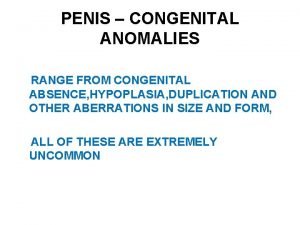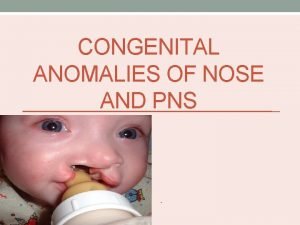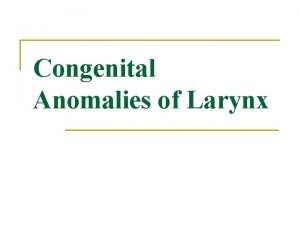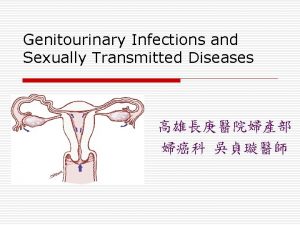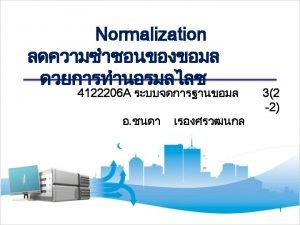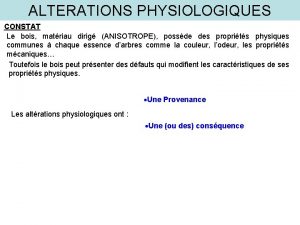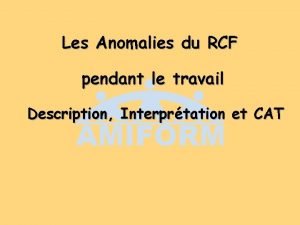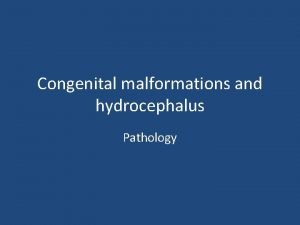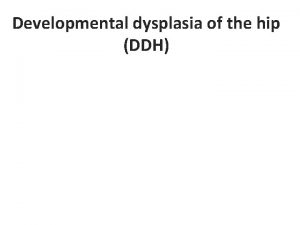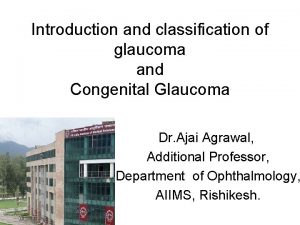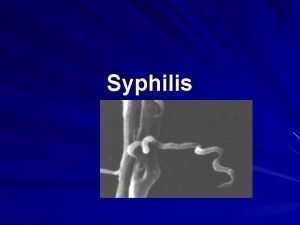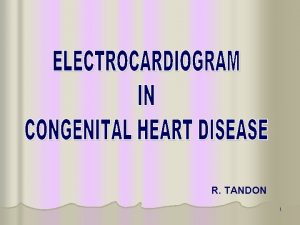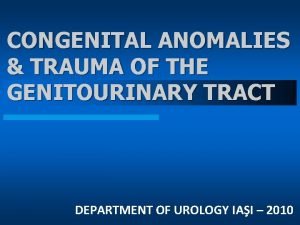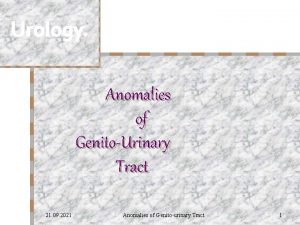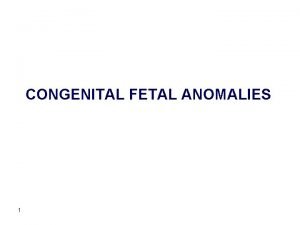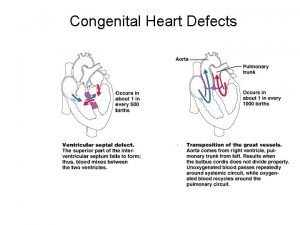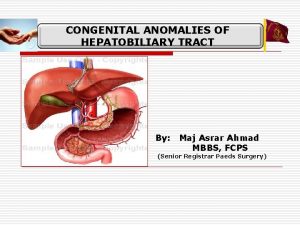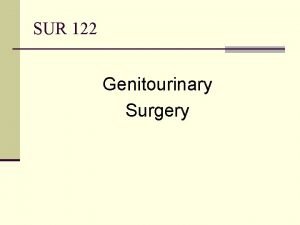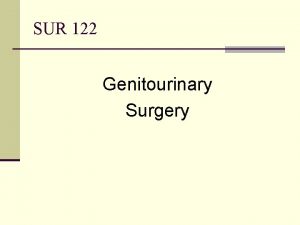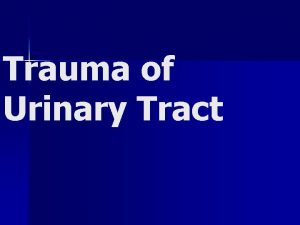CONGENITAL ANOMALIES TRAUMA OF THE GENITOURINARY TRACT DEPARTMENT

![CONGENITAL – KIDNEY ] ] ] ] more frequently than in any other organ CONGENITAL – KIDNEY ] ] ] ] more frequently than in any other organ](https://slidetodoc.com/presentation_image_h/0e2798952f7fcc042a26f85e76982f8f/image-2.jpg)

![CONGENITAL – KIDNEY Symptoms ] pain (drag on the vascular pedicles by the heavy CONGENITAL – KIDNEY Symptoms ] pain (drag on the vascular pedicles by the heavy](https://slidetodoc.com/presentation_image_h/0e2798952f7fcc042a26f85e76982f8f/image-4.jpg)
![CONGENITAL – KIDNEY uremia (anemia, loss of weight) Laboratory ] anemia (chronic loss of CONGENITAL – KIDNEY uremia (anemia, loss of weight) Laboratory ] anemia (chronic loss of](https://slidetodoc.com/presentation_image_h/0e2798952f7fcc042a26f85e76982f8f/image-5.jpg)
![CONGENITAL – KIDNEY Differential Diagnosis ] bilateral hydronephrosis ] bilateral renal tumor ] von CONGENITAL – KIDNEY Differential Diagnosis ] bilateral hydronephrosis ] bilateral renal tumor ] von](https://slidetodoc.com/presentation_image_h/0e2798952f7fcc042a26f85e76982f8f/image-6.jpg)
![CONGENITAL – KIDNEY Treatment ] General Measures: low-protein diet (0. 5 -0. 75 g/kg/d), CONGENITAL – KIDNEY Treatment ] General Measures: low-protein diet (0. 5 -0. 75 g/kg/d),](https://slidetodoc.com/presentation_image_h/0e2798952f7fcc042a26f85e76982f8f/image-7.jpg)
![CONGENITAL – KIDNEY SIMPLE (SOLITARY) CYST ] usually unilateral and single, but may be CONGENITAL – KIDNEY SIMPLE (SOLITARY) CYST ] usually unilateral and single, but may be](https://slidetodoc.com/presentation_image_h/0e2798952f7fcc042a26f85e76982f8f/image-8.jpg)
![CONGENITAL – KIDNEY Clinical Findings ] Symptoms: pain in the flank or back, intermittent CONGENITAL – KIDNEY Clinical Findings ] Symptoms: pain in the flank or back, intermittent](https://slidetodoc.com/presentation_image_h/0e2798952f7fcc042a26f85e76982f8f/image-9.jpg)
![CONGENITAL – KIDNEY Differential Diagnosis ] carcinoma of the kidney (walls of a simple CONGENITAL – KIDNEY Differential Diagnosis ] carcinoma of the kidney (walls of a simple](https://slidetodoc.com/presentation_image_h/0e2798952f7fcc042a26f85e76982f8f/image-10.jpg)
![CONGENITAL – KIDNEY RENAL FUSION ] ≈ 1‰, the most common – horseshoe kidney CONGENITAL – KIDNEY RENAL FUSION ] ≈ 1‰, the most common – horseshoe kidney](https://slidetodoc.com/presentation_image_h/0e2798952f7fcc042a26f85e76982f8f/image-11.jpg)
![CONGENITAL – KIDNEY Clinical findings ] Symptoms: no symptoms; ureteral obstruction; infection; calculus ] CONGENITAL – KIDNEY Clinical findings ] Symptoms: no symptoms; ureteral obstruction; infection; calculus ]](https://slidetodoc.com/presentation_image_h/0e2798952f7fcc042a26f85e76982f8f/image-12.jpg)
![CONGENITAL – KIDNEY Clinical findings ] CT – outlines the renal mass ] Retrograde CONGENITAL – KIDNEY Clinical findings ] CT – outlines the renal mass ] Retrograde](https://slidetodoc.com/presentation_image_h/0e2798952f7fcc042a26f85e76982f8f/image-13.jpg)
![CONGENITAL – KIDNEY ECTOPIC KIDNEY Simple Ectopy ] low kidney on the proper side CONGENITAL – KIDNEY ECTOPIC KIDNEY Simple Ectopy ] low kidney on the proper side](https://slidetodoc.com/presentation_image_h/0e2798952f7fcc042a26f85e76982f8f/image-14.jpg)
![CONGENITAL – KIDNEY ] ] ] ] ABNORMAL ROTATION IVU – abnormal position MEDULLARY CONGENITAL – KIDNEY ] ] ] ] ABNORMAL ROTATION IVU – abnormal position MEDULLARY](https://slidetodoc.com/presentation_image_h/0e2798952f7fcc042a26f85e76982f8f/image-15.jpg)
![CONGENITAL – URETER ] ] ] are common, may cause severe obstruction or may CONGENITAL – URETER ] ] ] are common, may cause severe obstruction or may](https://slidetodoc.com/presentation_image_h/0e2798952f7fcc042a26f85e76982f8f/image-16.jpg)
![CONGENITAL – URETER ] ] ] DUPLICATION OF THE URETER one of the most CONGENITAL – URETER ] ] ] DUPLICATION OF THE URETER one of the most](https://slidetodoc.com/presentation_image_h/0e2798952f7fcc042a26f85e76982f8f/image-17.jpg)
![CONGENITAL – URETER ] ] clinical findings – asymptomatic; persistent or recurrent infections; F CONGENITAL – URETER ] ] clinical findings – asymptomatic; persistent or recurrent infections; F](https://slidetodoc.com/presentation_image_h/0e2798952f7fcc042a26f85e76982f8f/image-18.jpg)
![CONGENITAL – URETER ] ] renal scanning (99 m. Tc-DMSA) – estimating the degree CONGENITAL – URETER ] ] renal scanning (99 m. Tc-DMSA) – estimating the degree](https://slidetodoc.com/presentation_image_h/0e2798952f7fcc042a26f85e76982f8f/image-19.jpg)
![CONGENITAL – URETER ] ] delayed or incomplete canalization of the ureteral bud early CONGENITAL – URETER ] ] delayed or incomplete canalization of the ureteral bud early](https://slidetodoc.com/presentation_image_h/0e2798952f7fcc042a26f85e76982f8f/image-20.jpg)
![CONGENITAL – URETER ] ] ] ECTOPIC URETERAL ORIFICE most commonly in association with CONGENITAL – URETER ] ] ] ECTOPIC URETERAL ORIFICE most commonly in association with](https://slidetodoc.com/presentation_image_h/0e2798952f7fcc042a26f85e76982f8f/image-21.jpg)
![CONGENITAL – URETER ] ] OBSTRUCTION OF THE URETEROPELVIC JUNCTION (UPJ) the most common CONGENITAL – URETER ] ] OBSTRUCTION OF THE URETEROPELVIC JUNCTION (UPJ) the most common](https://slidetodoc.com/presentation_image_h/0e2798952f7fcc042a26f85e76982f8f/image-22.jpg)

![CONGENITAL – URETHRA ] ] ] URETHRAL STRICTURE uncommon in infant boys (fossa navicularis CONGENITAL – URETHRA ] ] ] URETHRAL STRICTURE uncommon in infant boys (fossa navicularis](https://slidetodoc.com/presentation_image_h/0e2798952f7fcc042a26f85e76982f8f/image-24.jpg)
![CONGENITAL – URETHRA ] ] HYPOSPADIAS urethral meatus opens on the ventral side of CONGENITAL – URETHRA ] ] HYPOSPADIAS urethral meatus opens on the ventral side of](https://slidetodoc.com/presentation_image_h/0e2798952f7fcc042a26f85e76982f8f/image-25.jpg)
![CONGENITAL – TESTIS CRYPTORCHIDISM ] incidence: 3. 4 -5. 8% (at birth) & 1. CONGENITAL – TESTIS CRYPTORCHIDISM ] incidence: 3. 4 -5. 8% (at birth) & 1.](https://slidetodoc.com/presentation_image_h/0e2798952f7fcc042a26f85e76982f8f/image-26.jpg)
![CONGENITAL – TESTIS the higher the testis location the worse its histology ] unilateral CONGENITAL – TESTIS the higher the testis location the worse its histology ] unilateral](https://slidetodoc.com/presentation_image_h/0e2798952f7fcc042a26f85e76982f8f/image-27.jpg)
![CONGENITAL – TESTIS Treatment ] early (8 -12 months) risk of infertility, malignancy (10 CONGENITAL – TESTIS Treatment ] early (8 -12 months) risk of infertility, malignancy (10](https://slidetodoc.com/presentation_image_h/0e2798952f7fcc042a26f85e76982f8f/image-28.jpg)
![INJURIES TO THE G-U TRACT ] ] EMERGENCY DIAGNOSIS & MANAGEMENT 10% of all INJURIES TO THE G-U TRACT ] ] EMERGENCY DIAGNOSIS & MANAGEMENT 10% of all](https://slidetodoc.com/presentation_image_h/0e2798952f7fcc042a26f85e76982f8f/image-29.jpg)
![INJURIES TO THE G-U TRACT SPECIAL EXAMINATIONS Catheterization and Assessment of Injury (Staging) ] INJURIES TO THE G-U TRACT SPECIAL EXAMINATIONS Catheterization and Assessment of Injury (Staging) ]](https://slidetodoc.com/presentation_image_h/0e2798952f7fcc042a26f85e76982f8f/image-30.jpg)
![INJURIES TO THE G-U TRACT Catheterization and Assessment of Injury (Staging) ] arteriography – INJURIES TO THE G-U TRACT Catheterization and Assessment of Injury (Staging) ] arteriography –](https://slidetodoc.com/presentation_image_h/0e2798952f7fcc042a26f85e76982f8f/image-31.jpg)
![INJURIES TO THE KIDNEY the most common injuries of the urinary system ] pathologic INJURIES TO THE KIDNEY the most common injuries of the urinary system ] pathologic](https://slidetodoc.com/presentation_image_h/0e2798952f7fcc042a26f85e76982f8f/image-32.jpg)


![INJURIES TO THE KIDNEY ] ] ] signs – shock or signs of a INJURIES TO THE KIDNEY ] ] ] signs – shock or signs of a](https://slidetodoc.com/presentation_image_h/0e2798952f7fcc042a26f85e76982f8f/image-35.jpg)
![INJURIES TO THE KIDNEY Complications ] early – hemorrhage (persistent retroperitoneal bleeding or heavy INJURIES TO THE KIDNEY Complications ] early – hemorrhage (persistent retroperitoneal bleeding or heavy](https://slidetodoc.com/presentation_image_h/0e2798952f7fcc042a26f85e76982f8f/image-36.jpg)
![INJURIES TO THE KIDNEY ] complications ] retroperitoneal urinoma or perinephric abscess surgical drainage INJURIES TO THE KIDNEY ] complications ] retroperitoneal urinoma or perinephric abscess surgical drainage](https://slidetodoc.com/presentation_image_h/0e2798952f7fcc042a26f85e76982f8f/image-37.jpg)


![INJURIES TO THE BLADDER Treatment ] shock & hemorrhage treatment ] extraperitoneal – urethral INJURIES TO THE BLADDER Treatment ] shock & hemorrhage treatment ] extraperitoneal – urethral](https://slidetodoc.com/presentation_image_h/0e2798952f7fcc042a26f85e76982f8f/image-40.jpg)
![INJURIES TO THE URETHRA ] ] ] ] INJURIES TO THE POSTERIOR URETHRA pelvic INJURIES TO THE URETHRA ] ] ] ] INJURIES TO THE POSTERIOR URETHRA pelvic](https://slidetodoc.com/presentation_image_h/0e2798952f7fcc042a26f85e76982f8f/image-41.jpg)
- Slides: 41

CONGENITAL ANOMALIES & TRAUMA OF THE GENITOURINARY TRACT DEPARTMENT OF UROLOGY IAŞI – 2013
![CONGENITAL KIDNEY more frequently than in any other organ CONGENITAL – KIDNEY ] ] ] ] more frequently than in any other organ](https://slidetodoc.com/presentation_image_h/0e2798952f7fcc042a26f85e76982f8f/image-2.jpg)
CONGENITAL – KIDNEY ] ] ] ] more frequently than in any other organ many cause impairment of renal function association with other renal and extrarenal congenital anomalies AGENESIS bilateral – extremely rare; children do not survive; prenatal suspicion – oligohydramnios (US) unilateral – no symptoms; cystoscopy – ureteral ridge absent, no orifice visualized; definitive diagnosis – isotope studies, US, CT HYPOPLASIA small kidney, smtm dysplastic; the other maybe larger than normal observed in infants with fetal alcohol syndrome or in utero cocaine exposure

CONGENITAL – KIDNEY differentiation – acquired atrophy (atrophic pyelonephritis, VUR, stenosis of the renal artery) ] associated with hypertension nephrectomy ADULT POLYCYSTIC KIDNEY DISEASE ] autosomal dominant hereditary condition; almost always bilateral (95%) ] in infants – autosomal recessive disease; short life expectancy ] cysts of the liver, spleen and pancreas Etiology & Pathogenesis ] defects in the development of the collecting and uriniferous tubules and in the mechanism of their joining blind secretory tubules connected to functioning glomeruli cysts enlarge & compress adjacent parenchyma destroy it by ischemia and occlude normal tubules progressive functional impairment ]
![CONGENITAL KIDNEY Symptoms pain drag on the vascular pedicles by the heavy CONGENITAL – KIDNEY Symptoms ] pain (drag on the vascular pedicles by the heavy](https://slidetodoc.com/presentation_image_h/0e2798952f7fcc042a26f85e76982f8f/image-4.jpg)
CONGENITAL – KIDNEY Symptoms ] pain (drag on the vascular pedicles by the heavy kidneys, obstruction, infection, hemorrhage into a cyst) ] gross or microscopic total hematuria ] colic (blood clots or stones) ] abdominal mass ] infection (chills, fever, renal pain) ] renal insufficiency (headache, nausea, vomiting, weakness, loss of weight) Signs ] palpable kidneys (nodular, tender if infected) ] hypertension ( 60 -70%) ] fever (pyelonephritis or infected cysts)
![CONGENITAL KIDNEY uremia anemia loss of weight Laboratory anemia chronic loss of CONGENITAL – KIDNEY uremia (anemia, loss of weight) Laboratory ] anemia (chronic loss of](https://slidetodoc.com/presentation_image_h/0e2798952f7fcc042a26f85e76982f8f/image-5.jpg)
CONGENITAL – KIDNEY uremia (anemia, loss of weight) Laboratory ] anemia (chronic loss of blood or hematopoietic depression of uremia) ] proteinuria and hematuria; pyuria and bacteriuria ] progressive creatinine clearance US – multiple transsonic images, large renal size IVU ] enlarged renal shadows on a plain film ] bizarre (spider deformity) caliceal pattern (broadened, flattened, enlarged, curved) CT – extremely accurate (95%) for diagnosis – multiple thin-walled cysts filled with fluid, large renal size ]
![CONGENITAL KIDNEY Differential Diagnosis bilateral hydronephrosis bilateral renal tumor von CONGENITAL – KIDNEY Differential Diagnosis ] bilateral hydronephrosis ] bilateral renal tumor ] von](https://slidetodoc.com/presentation_image_h/0e2798952f7fcc042a26f85e76982f8f/image-6.jpg)
CONGENITAL – KIDNEY Differential Diagnosis ] bilateral hydronephrosis ] bilateral renal tumor ] von Hippel-Lindau disease (angiomatous cerebellar cyst, angiomatosis of the retina, tumors or cysts of the pancreas, multiple bilateral cysts or adenocarcinomas of both kidneys) ] tuberous sclerosis (convulsive seizures, mental retardation, adenoma sebaceum, hamartomatous tumors of the skin, brain, retinas, bones, liver, heart, and kidneys) simple cyst Complications ] pyelonephritis ] infection of cysts ] severe gross hematuria ]
![CONGENITAL KIDNEY Treatment General Measures lowprotein diet 0 5 0 75 gkgd CONGENITAL – KIDNEY Treatment ] General Measures: low-protein diet (0. 5 -0. 75 g/kg/d),](https://slidetodoc.com/presentation_image_h/0e2798952f7fcc042a26f85e76982f8f/image-7.jpg)
CONGENITAL – KIDNEY Treatment ] General Measures: low-protein diet (0. 5 -0. 75 g/kg/d), fluids (≥ 3 L/d), reasonable physical activity, treatment of uremia (hemodialysis), control of hypertension ] Surgery: a large cyst compressing the upper ureter (obstruction and impairment of renal function) resected or aspirated; renal insufficiency chronic dialysis or renal transplantation ] Treatment of Complications: pyelonephritis; infection of cysts surgical or percutaneous drainage; severe bleeding nephrectomy or selective embolization Prognosis ] children – very poor ] clinical signs and symptoms after age 35 -40 – more favorable
![CONGENITAL KIDNEY SIMPLE SOLITARY CYST usually unilateral and single but may be CONGENITAL – KIDNEY SIMPLE (SOLITARY) CYST ] usually unilateral and single, but may be](https://slidetodoc.com/presentation_image_h/0e2798952f7fcc042a26f85e76982f8f/image-8.jpg)
CONGENITAL – KIDNEY SIMPLE (SOLITARY) CYST ] usually unilateral and single, but may be multiple and multilocular; more rarely, bilateral Etiology & Pathogenesis ] origin may be similar to that of polycystic kidneys, but the lesion can be acquired (chronic dialysis) ] as it grows compresses and may destroy renal parenchyma; may compress the ureter progressive hydronephrosis ] spontaneous regression of cysts has occasionally been noted Pathology ] 5% contain hemorrhagic fluid (1/2 have papillary cancers on their walls)
![CONGENITAL KIDNEY Clinical Findings Symptoms pain in the flank or back intermittent CONGENITAL – KIDNEY Clinical Findings ] Symptoms: pain in the flank or back, intermittent](https://slidetodoc.com/presentation_image_h/0e2798952f7fcc042a26f85e76982f8f/image-9.jpg)
CONGENITAL – KIDNEY Clinical Findings ] Symptoms: pain in the flank or back, intermittent and dull; severe pain (bleeding); mass in the abdomen; pain in the flank, malaise, and fever (infected cyst) ] Signs: mass palpated or percussed; tenderness in the flank (infected cyst) ] Laboratory: usually normal ] US – differentiates between a cyst and a solid mass; percutaneous cyst aspiration ] CT – differentiates renal cyst and tumor (attenuation of cysts ≈ water, density of tumors ≈ parenchyma; parenchyma more dense with contrast i. v. , cyst unaffected) ] Percutaneous Cyst Aspiration With Cystography: differentiation between cyst and tumor
![CONGENITAL KIDNEY Differential Diagnosis carcinoma of the kidney walls of a simple CONGENITAL – KIDNEY Differential Diagnosis ] carcinoma of the kidney (walls of a simple](https://slidetodoc.com/presentation_image_h/0e2798952f7fcc042a26f85e76982f8f/image-10.jpg)
CONGENITAL – KIDNEY Differential Diagnosis ] carcinoma of the kidney (walls of a simple cyst – cancerous degeneration) ] polycystic kidney disease, renal carbuncle, hydronephrosis ] extrarenal tumor (adrenal, mixed retroperitoneal sarcoma) ] echinococcal (hydatid) cyst of the kidney Complications (rare) – spontaneous infection, hemorrhage into the cyst, hydronephrosis (cyst of the lower pole) Treatment ] follow-up with US; if no definitive diagnosis with US, CT or MRI perc. needle aspiration (clear fluid benign cyst), cytologic evaluation, cystography; hemorrhagic fluid surgical exploration ] complications: infected cyst intensive antimicrobial therapy + percutaneous or surgical drainage; hydronephrosis percutaneous puncture, aspiration & sclerotherapy
![CONGENITAL KIDNEY RENAL FUSION 1 the most common horseshoe kidney CONGENITAL – KIDNEY RENAL FUSION ] ≈ 1‰, the most common – horseshoe kidney](https://slidetodoc.com/presentation_image_h/0e2798952f7fcc042a26f85e76982f8f/image-11.jpg)
CONGENITAL – KIDNEY RENAL FUSION ] ≈ 1‰, the most common – horseshoe kidney Etiology & Pathogenesis ] fusion of the 2 metanephroi occurs early in embryologic life seldom ascend to the normal position (may remain in the pelvis); may derive its blood supply from many vessels (aorta, iliacs) Pathology ] normal rotation cannot occur each pelvis lies on the anterior surface ureter must ride over the isthmus (horseshoe kidney) or traverse the anterior surface (fused kidney) ureteral compression hydronephrosis ] horseshoe kidney: isthmus joins the lower poles of each kidney; each renal mass lies lower than normal; axes of the masses are vertical or divergent upwards
![CONGENITAL KIDNEY Clinical findings Symptoms no symptoms ureteral obstruction infection calculus CONGENITAL – KIDNEY Clinical findings ] Symptoms: no symptoms; ureteral obstruction; infection; calculus ]](https://slidetodoc.com/presentation_image_h/0e2798952f7fcc042a26f85e76982f8f/image-12.jpg)
CONGENITAL – KIDNEY Clinical findings ] Symptoms: no symptoms; ureteral obstruction; infection; calculus ] Signs: usually negative; abnormally placed renal mass (horseshoe kidney – palpable mass over the lower lumbar spine [isthmus], crossed ectopy – mass in the flank or lower abdomen) ] Laboratory: normal ] X-Ray: horseshoe kidney – axes of the kidneys parallel to the spine on a plain film, isthmus can be identified; large soft-tissue mass in one flank w/o a renal shadow on the other side ] IVU: horseshoe kidney – renal pelves lie on the anterior surfaces of the kidney masses, calyces in the lower pole that point medially and lie medial to the ureter; crossed renal ectopy with fusion – 2 pelves and 2 ureters (one ureter must cross the midline); cake or lump kidney (fused pelvis kidney) – may compress the dome of the bladder
![CONGENITAL KIDNEY Clinical findings CT outlines the renal mass Retrograde CONGENITAL – KIDNEY Clinical findings ] CT – outlines the renal mass ] Retrograde](https://slidetodoc.com/presentation_image_h/0e2798952f7fcc042a26f85e76982f8f/image-13.jpg)
CONGENITAL – KIDNEY Clinical findings ] CT – outlines the renal mass ] Retrograde urograms: show the position of theureters and pelves (pelvic fused kidney) ] Renal scanning: delineates the renal mass and its contour Differential Diagnosis - separate kidneys that fail to undergo normal rotation, other abdominal masses Complications – ureteral obstruction, hydronephrosis, stone, infection, dystocia due to a large fused kidney occupying the concavity of the sacrum Treatment – no treatment unless obstruction or infection; drainage of a horseshoe kidney by dividing the isthmus; surgical resection
![CONGENITAL KIDNEY ECTOPIC KIDNEY Simple Ectopy low kidney on the proper side CONGENITAL – KIDNEY ECTOPIC KIDNEY Simple Ectopy ] low kidney on the proper side](https://slidetodoc.com/presentation_image_h/0e2798952f7fcc042a26f85e76982f8f/image-14.jpg)
CONGENITAL – KIDNEY ECTOPIC KIDNEY Simple Ectopy ] low kidney on the proper side that failed to ascend normally (may lie in the pelvis), blood supply from adjacent vessels, short ureter; prone to ureteral obstruction and infection pain or fever ] may be palpable - differential diagnosis (cancer of the bowel, appendiceal abscess) ] IVU – position of the kidney; no redundancy of the ureter (as with nephroptosis or acquired ectopy [displacement by large adrenal tumor]) ] treatment of obstruction and infection Crossed Ectopy Without Fusion ] the kidney lies on the opposite side – US, angiography or CT for diagnosis
![CONGENITAL KIDNEY ABNORMAL ROTATION IVU abnormal position MEDULLARY CONGENITAL – KIDNEY ] ] ] ] ABNORMAL ROTATION IVU – abnormal position MEDULLARY](https://slidetodoc.com/presentation_image_h/0e2798952f7fcc042a26f85e76982f8f/image-15.jpg)
CONGENITAL – KIDNEY ] ] ] ] ABNORMAL ROTATION IVU – abnormal position MEDULLARY SPONGE KIDNEY congenital autosomal recessive defect – cystic dilatation of the renal collecting tubules (usually bilateral, affecting all of the papillae) urinary stasis in the tubules infection and calculi symptoms – from infection and stone formation diagnosis (IVU or CT): pelvis and calyces are normal, but dilated (streaked) tubules (cystic dilatation); plain film – small, round calculi in the pyramidal regions (just beyond the calyces) differential diagnosis: tuberculosis, healed papillary necrosis, nephrocalcinosis terapy of the complications (pyelonephritis, renal calculi)
![CONGENITAL URETER are common may cause severe obstruction or may CONGENITAL – URETER ] ] ] are common, may cause severe obstruction or may](https://slidetodoc.com/presentation_image_h/0e2798952f7fcc042a26f85e76982f8f/image-16.jpg)
CONGENITAL – URETER ] ] ] are common, may cause severe obstruction or may be asymptomatic and of no clinical significance URETERAL ATRESIA ureter may be absent entirely or may end blindly after extending only part of the way to the flank embryologically – failure of the ureteral bud to form from the mesonephric duct or by an arrest in its development before it comes in contact with the metanephric blastema atretic ureteral bud absent or multicystic, dysplastic kidney, (rarely associated with hypertension, infection or tumor); contralateral VUR is common (voiding cystourethrogram) treatment – observation
![CONGENITAL URETER DUPLICATION OF THE URETER one of the most CONGENITAL – URETER ] ] ] DUPLICATION OF THE URETER one of the most](https://slidetodoc.com/presentation_image_h/0e2798952f7fcc042a26f85e76982f8f/image-17.jpg)
CONGENITAL – URETER ] ] ] DUPLICATION OF THE URETER one of the most common congenital malformations of the urinary tract (0. 9%); autosomal dominant; F>M; often bilateral incomplete (Y) type – caused by branching of the ureteral bud before it reaches the metanephric blastema; disorders of peristalsis may occur near the point of union complete type – 2 ureteral buds 2 totally separate ureters and 2 separate renal pelves; the ureter to the upper segment migrates farther, ending medial and inferior to the ureter draining the lower segment (Weigert-Meyer law) the ureter draining the upper segment may migrate too far caudally and become ectopic and obstructed; the ureter draining the lower segment may end laterally and have a short intravesical tunnel VUR
![CONGENITAL URETER clinical findings asymptomatic persistent or recurrent infections F CONGENITAL – URETER ] ] clinical findings – asymptomatic; persistent or recurrent infections; F](https://slidetodoc.com/presentation_image_h/0e2798952f7fcc042a26f85e76982f8f/image-18.jpg)
CONGENITAL – URETER ] ] clinical findings – asymptomatic; persistent or recurrent infections; F – ureter to the upper pole may be ectopic, distal to the external sphincter or outside the urinary tract true incontinence + normal pattern of voiding; M – ectopic ureter is always proximal to the external sphincter (w/o incontinence) IVU – duplication; occasionally, one segment of the kidney is not visualized, but there is displacement of the visualized calyces or ureter or discrepancy between the amount of renal parenchyma and the relatively small number of visualized calyces voiding cystourethrogram – VUR or ureterocele US – hydronephrotic upper pole and dilated distal ureter; evaluate parenchymal thickness and the presence of bladder anomalies
![CONGENITAL URETER renal scanning 99 m TcDMSA estimating the degree CONGENITAL – URETER ] ] renal scanning (99 m. Tc-DMSA) – estimating the degree](https://slidetodoc.com/presentation_image_h/0e2798952f7fcc042a26f85e76982f8f/image-19.jpg)
CONGENITAL – URETER ] ] renal scanning (99 m. Tc-DMSA) – estimating the degree of renal function in each renal segment treatment ] lower grades of reflux medically ] higher grades of reflux surgically ] very poor renal function in one segment heminephrectomy ] to preserve renal parenchyma pyeloureterostomy, ureterostomy or ureteral reimplantation URETEROCELE sacculation of the terminal portion of the ureter; it may be intravesical or ectopic (bladder neck or urethra) F: M = 7: 1; ≈ 10% are bilateral
![CONGENITAL URETER delayed or incomplete canalization of the ureteral bud early CONGENITAL – URETER ] ] delayed or incomplete canalization of the ureteral bud early](https://slidetodoc.com/presentation_image_h/0e2798952f7fcc042a26f85e76982f8f/image-20.jpg)
CONGENITAL – URETER ] ] delayed or incomplete canalization of the ureteral bud early prenatal obstruction and expansion of the ureteral bud; forms between the superficial and deep muscle layers of the trigone clinical findings – infection; bladder outlet obstruction or incontinence; calculi can develop in the distal ureter IVU, US – significant ureterohydronephrosis and a dysplastic segment of the upper pole of the kidney; voiding cystourethrography – reflux into the lower pole or contralateral ureter; renal scanning – estimating renal function treatment – transurethral incision; heminephrectomy and ureterectomy, excision of the ureterocele, vesical reconstruction, ureteral reimplantation
![CONGENITAL URETER ECTOPIC URETERAL ORIFICE most commonly in association with CONGENITAL – URETER ] ] ] ECTOPIC URETERAL ORIFICE most commonly in association with](https://slidetodoc.com/presentation_image_h/0e2798952f7fcc042a26f85e76982f8f/image-21.jpg)
CONGENITAL – URETER ] ] ] ECTOPIC URETERAL ORIFICE most commonly in association with duplication of the ureter caused by a delay or failure of separation of the ureteral bud from the mesonephric duct clinical picture: M – urinary tract infection or epididymitis (ureter may drain directly into the vas deferens or seminal vesicle); F – continual dribbling despite normal voiding – pathognomonic (ureteral orifice in the urethra, vagina or perineum), infection (urgency and urge incontinence) US, voiding cystourethrography, MRI, cystoscopy (hemitrigone, ectopic orifice may be visualized or demonstrated by retrograde catheterization) or laparoscopy renal scanning – estimates relative renal function
![CONGENITAL URETER OBSTRUCTION OF THE URETEROPELVIC JUNCTION UPJ the most common CONGENITAL – URETER ] ] OBSTRUCTION OF THE URETEROPELVIC JUNCTION (UPJ) the most common](https://slidetodoc.com/presentation_image_h/0e2798952f7fcc042a26f85e76982f8f/image-22.jpg)
CONGENITAL – URETER ] ] OBSTRUCTION OF THE URETEROPELVIC JUNCTION (UPJ) the most common congenital abnormality of the ureter; M: F = 5: 2; L: R = 5: 2 bilateral obstruction – 10 -15%, especially common in infants cause of obstruction (intrinsic or extrinsic): ureteral polyps and valves (very rare), angulation and kink at the junction, true stenosis (rarely), thin-walled, hypoplastic proximal ureter (frequently), histologic and ultrastructural changes abnormal peristalsis through the UPJ and interference with pelvic emptying, high origin of the ureter from the renal pelvis, abnormal relationship of the UPJ to a lower-pole renal artery clinical findings - most common symptoms: pain and vomiting; hematuria, urinary infection, calculi, trauma to the enlarged kidney or (rarely) hypertension

CONGENITAL – URETER US – diagnosis; prenatal US – diagnosis in utero; in equivocal cases, diuretic renography or antegrade urography with pressureflow studies; voiding cystourethrogram – findings in VUR may be similar Therapy: symptomatic obstruction treated surgically; early surgery – kidneys with diminished function, massive hydronephrosis, infection or stones; nonoperative surveillance with close follow-up ] procedures: dismembered pyeloureteroplasty (Anderson-Hynes), Foley Y-V plasty, pelvic flap procedures (Culp, Scardino) ] endopyelotomy – antegrade, via a nephrostomy tract, or retrograde, using either a ureteroscope (for direct vision) or an Acucise balloon catheter with fluoroscopic visualization ] laparoscopic pyeloplasty ]
![CONGENITAL URETHRA URETHRAL STRICTURE uncommon in infant boys fossa navicularis CONGENITAL – URETHRA ] ] ] URETHRAL STRICTURE uncommon in infant boys (fossa navicularis](https://slidetodoc.com/presentation_image_h/0e2798952f7fcc042a26f85e76982f8f/image-24.jpg)
CONGENITAL – URETHRA ] ] ] URETHRAL STRICTURE uncommon in infant boys (fossa navicularis and membranous urethra) severe strictures may cause bladder damage and hydronephrosis symptoms of obstruction or urinary infection POSTERIOR URETHRAL VALVES the most common obstructive urethral lesions in male infants and newborns treatment – destruction of the valves – transurethral fulguration of the valves
![CONGENITAL URETHRA HYPOSPADIAS urethral meatus opens on the ventral side of CONGENITAL – URETHRA ] ] HYPOSPADIAS urethral meatus opens on the ventral side of](https://slidetodoc.com/presentation_image_h/0e2798952f7fcc042a26f85e76982f8f/image-25.jpg)
CONGENITAL – URETHRA ] ] HYPOSPADIAS urethral meatus opens on the ventral side of the penis proximal to the tip of the glans penis repair with foreskin island flaps/buccal mucosa grafts and incised urethral plate EPISPADIAS urethra opens on the dorsal aspect of the penis; a distal groove extends from the meatus through the glans surgery is required to correct the incontinence, remove the chordee to straighten the penis, and extend the urethra out onto the glans penis
![CONGENITAL TESTIS CRYPTORCHIDISM incidence 3 4 5 8 at birth 1 CONGENITAL – TESTIS CRYPTORCHIDISM ] incidence: 3. 4 -5. 8% (at birth) & 1.](https://slidetodoc.com/presentation_image_h/0e2798952f7fcc042a26f85e76982f8f/image-26.jpg)
CONGENITAL – TESTIS CRYPTORCHIDISM ] incidence: 3. 4 -5. 8% (at birth) & 1. 8% (1 year – puberty) after the first year spontaneous descent is unlikely to occur ] ectopic – descend normally through the external inguinal ring, then misdirected to an extrascrotal position (superficial inguinal, perineal, prepenile, transverse scrotal, femoral or umbilical) ] true cryptorchid – arrested in their normal line of descent (intraabdominal, intracanalicular or suprascrotal) ] 1/3 of cryptorchid cases are bilateral infertility Histology and Endocrine Pathology ] reduced number of germ cells (2 nd year, persists thereafter) ] impaired function of the hypothalamic-pituitary-gonadal axis testosterone failure of testicular descent + failure of proliferation and maturation of germ cells
![CONGENITAL TESTIS the higher the testis location the worse its histology unilateral CONGENITAL – TESTIS the higher the testis location the worse its histology ] unilateral](https://slidetodoc.com/presentation_image_h/0e2798952f7fcc042a26f85e76982f8f/image-27.jpg)
CONGENITAL – TESTIS the higher the testis location the worse its histology ] unilateral cryptorchidism is a bilateral disease contralateral descended testis is abnormal – similar abnormalities, but to a lesser degree subfertility Diagnosis ] every general pediatric examination in boys – examination of the testicular position! ] US – high false-negative rate! (testis present despite negative ultrasound) ] CT (irradiation!) & MRI ] selective diagnostic laparoscopy orchidopexy or orchiectomy ]
![CONGENITAL TESTIS Treatment early 8 12 months risk of infertility malignancy 10 CONGENITAL – TESTIS Treatment ] early (8 -12 months) risk of infertility, malignancy (10](https://slidetodoc.com/presentation_image_h/0e2798952f7fcc042a26f85e76982f8f/image-28.jpg)
CONGENITAL – TESTIS Treatment ] early (8 -12 months) risk of infertility, malignancy (10 -46 ) and testicular torsion ] hormonal treatment induction of testicular descent and stimulation of germ cell maturation and proliferation ] h. CG ] Gn. RH (Kryptokur) nasal spray 1. 2 mg/d, 28 d, followed by h. CG 1, 500 IU/wk, 3 wks ] LHRH analog (Buserelin) – nasal spray ] early orchiopexy (≤ 1 year) ] postpubertal – orchiectomy
![INJURIES TO THE GU TRACT EMERGENCY DIAGNOSIS MANAGEMENT 10 of all INJURIES TO THE G-U TRACT ] ] EMERGENCY DIAGNOSIS & MANAGEMENT 10% of all](https://slidetodoc.com/presentation_image_h/0e2798952f7fcc042a26f85e76982f8f/image-29.jpg)
INJURIES TO THE G-U TRACT ] ] EMERGENCY DIAGNOSIS & MANAGEMENT 10% of all injuries initial assessment – control of hemorrhage and shock, along with resuscitation (i. v. lines and urethral catheter – blood at the urethral meatus? ) history – detailed description of the accident (? gunshot wounds – type and caliber) examination of abdomen and genitalia ] contusions or subcutaneous hematomas ] fractures of the lower ribs and/or the bony pelvis ] diffuse abdominal tenderness
![INJURIES TO THE GU TRACT SPECIAL EXAMINATIONS Catheterization and Assessment of Injury Staging INJURIES TO THE G-U TRACT SPECIAL EXAMINATIONS Catheterization and Assessment of Injury (Staging) ]](https://slidetodoc.com/presentation_image_h/0e2798952f7fcc042a26f85e76982f8f/image-30.jpg)
INJURIES TO THE G-U TRACT SPECIAL EXAMINATIONS Catheterization and Assessment of Injury (Staging) ] catheterization – blood at the urethral meatus in men urethral injury catheterization should not be attempted, but retrograde urethrography; no blood urethral catheter ? microscopic or gross hematuria ] abdominal CT with contrast media – retroperitoneal hematoma, renal lacerations, urinary extravasation, renal arterial and venous injuries, intra-abdominal injuries (liver, spleen, pancreas, bowel) ] retrograde cystography (≥ 300 m. L) – ? bladder perforations ] retrograde urethrography (12 F/3 m. L) – 20 m. L
![INJURIES TO THE GU TRACT Catheterization and Assessment of Injury Staging arteriography INJURIES TO THE G-U TRACT Catheterization and Assessment of Injury (Staging) ] arteriography –](https://slidetodoc.com/presentation_image_h/0e2798952f7fcc042a26f85e76982f8f/image-31.jpg)
INJURIES TO THE G-U TRACT Catheterization and Assessment of Injury (Staging) ] arteriography – renal parenchymal and vascular injuries, persistent bleeding from pelvic fractures embolization with Gelfoam or autologous clot ] IVU – detect renal and ureteral injury Cystoscopy and Retrograde Uretero-Pyelography ] seldom necessary Abdominal Sonography ] if CT not available
![INJURIES TO THE KIDNEY the most common injuries of the urinary system pathologic INJURIES TO THE KIDNEY the most common injuries of the urinary system ] pathologic](https://slidetodoc.com/presentation_image_h/0e2798952f7fcc042a26f85e76982f8f/image-32.jpg)
INJURIES TO THE KIDNEY the most common injuries of the urinary system ] pathologic kidneys (hydronephrosis, malignant tumors etc. ) are more readily ruptured from mild trauma Etiology ] blunt trauma to the abdomen, flank or back (85%) ] rapid deceleration can cause major vascular injury ] gunshot and knife wounds penetrating injuries ] associated abdominal visceral injuries are common! Pathology & Classification ] early pathologic findings – grade ] 1 – renal contusion or bruising of the renal parenchyma microscopic hematuria ]

INJURIES TO THE KIDNEY 2 – renal parenchymal laceration into the cortex small perirenal hematoma ] 3 – renal parenchymal laceration extending through the cortex and into the medulla significant bleeding, large retroperitoneal hematoma ] 4 – renal parenchymal laceration extending into the collecting system; main renal artery thrombosis from blunt trauma, segmental renal vein or both; artery injury with contained bleeding ] 5 – multiple grade 4 parenchymal lacerations, renal pedicle avulsion or both; main renal vein or artery injury from penetrating trauma late pathologic findings – urinoma, hydronephrosis, arteriovenous fistula, renal vascular hypertension ] ]

INJURIES TO THE KIDNEY late pathologic findings – urinoma, hydronephrosis, arteriovenous fistula, renal vascular hypertension Clinical Findings & Indications for Studies ] some cases of renal vascular injury (deceleration) are not associated with hematuria imaging studies ] the degree of renal injury does not correspond to the degree of hematuria ] gross hematuria or microscopic hematuria with shock (systolic BP < 90 mm Hg) imaging studies ] symptoms – pain (flank or over the abdomen), hematuria, abdominal distention, ileus, nausea and vomiting (retroperitoneal bleeding ) ]
![INJURIES TO THE KIDNEY signs shock or signs of a INJURIES TO THE KIDNEY ] ] ] signs – shock or signs of a](https://slidetodoc.com/presentation_image_h/0e2798952f7fcc042a26f85e76982f8f/image-35.jpg)
INJURIES TO THE KIDNEY ] ] ] signs – shock or signs of a large loss of blood (heavy retroperitoneal bleeding), ecchymosis in the flank or upper quadrants of the abdomen, lower rib fractures, diffuse abdominal tenderness ] "acute abdomen" – free blood in the peritoneal cavity ] palpable mass ≈ large retroperitoneal hematoma or urinary extravasation (torn retroperitoneum free blood in the peritoneal cavity, but no palpable mass) laboratory – microscopic or gross hematuria, anemia (acute or chronic) staging systematic approach ] abdominal CT scan parenchymal lacerations, urinary extravasation, extent of the retroperitoneal hematoma, nonviable tissue, injuries to surrounding organs ] arteriography – major arterial and parenchymal injuries
![INJURIES TO THE KIDNEY Complications early hemorrhage persistent retroperitoneal bleeding or heavy INJURIES TO THE KIDNEY Complications ] early – hemorrhage (persistent retroperitoneal bleeding or heavy](https://slidetodoc.com/presentation_image_h/0e2798952f7fcc042a26f85e76982f8f/image-36.jpg)
INJURIES TO THE KIDNEY Complications ] early – hemorrhage (persistent retroperitoneal bleeding or heavy gross hematuria), urinary extravasation (urinoma) abscess formation & sepsis ] late – hypertension, hydronephrosis, arteriovenous fistula, calculus formation, pyelonephritis, heavy late bleeding ! Treatment ] emergency measures – prompt treatment of shock and hemorrhage, complete resuscitation and evaluation of associated injuries ] surgical measures ] blunt trauma (< 5%) – persistent retroperitoneal bleeding, urinary extravasation, nonviable renal parenchyma and renal pedicle injuries ] penetrating injuries – surgically explored (associated organ injury)
![INJURIES TO THE KIDNEY complications retroperitoneal urinoma or perinephric abscess surgical drainage INJURIES TO THE KIDNEY ] complications ] retroperitoneal urinoma or perinephric abscess surgical drainage](https://slidetodoc.com/presentation_image_h/0e2798952f7fcc042a26f85e76982f8f/image-37.jpg)
INJURIES TO THE KIDNEY ] complications ] retroperitoneal urinoma or perinephric abscess surgical drainage ] malignant hypertension vascular repair or nephrectomy ] hydronephrosis surgical correction or nephrectomy

INJURIES TO THE URETER rare, during difficult pelvic surgical procedures, gunshot wounds, rapid deceleration accidents (avulsion of the ureter from the renal pelvis), endoscopic procedures (ureteroscopies, basket manipulation of ureteral calculi) ] flank & abdominal pain, nausea, vomiting, ileus; vaginal or cutaneous fistula ] imaging: IVU, CT scan Treatment – prompt repair (if stenting not feasible) ] immediate – ureterostomy, transureterostomy, reimplantation into the bladder, autotransplantation of the kidney, bowel replacement of the ureter + stenting ] late – percutaneous nephrostomy, then repair ]

INJURIES TO THE BLADDER occur most often from external force and are often associated with pelvic fractures ] iatrogenic injury – gynecologic and surgical extensive pelvic procedures and transurethral operations Pathogenesis & Pathology ] extraperitoneal: pelvic fractures extraperitoneal rupture urine extravasation deep pelvic abscess ] intraperitoneal acute abdomen (peritonitis) Clinical findings ] KUB – pelvic fractures ] CT scan ] retrograde cystography ]
![INJURIES TO THE BLADDER Treatment shock hemorrhage treatment extraperitoneal urethral INJURIES TO THE BLADDER Treatment ] shock & hemorrhage treatment ] extraperitoneal – urethral](https://slidetodoc.com/presentation_image_h/0e2798952f7fcc042a26f85e76982f8f/image-40.jpg)
INJURIES TO THE BLADDER Treatment ] shock & hemorrhage treatment ] extraperitoneal – urethral catheter drainage (10 d); cystoraphy ] intraperitoneal – transperitoneal approach, cystoraphy, bladder & peritoneal drainage
![INJURIES TO THE URETHRA INJURIES TO THE POSTERIOR URETHRA pelvic INJURIES TO THE URETHRA ] ] ] ] INJURIES TO THE POSTERIOR URETHRA pelvic](https://slidetodoc.com/presentation_image_h/0e2798952f7fcc042a26f85e76982f8f/image-41.jpg)
INJURIES TO THE URETHRA ] ] ] ] INJURIES TO THE POSTERIOR URETHRA pelvic fractures from blunt trauma the membranous urethra is sheared from the prostatic apex acute retention of urine retrograde urethrogram treatment – suprapubic cystostomy, delayed urethral reconstruction INJURIES TO THE ANTERIOR URETHRA straddle injury, self- or iatrogenic instrumentation urethral bleeding ± retention of urine; retrograde urethrogram urethral contusion no instrumentation or urethral catheter urethral laceration suprapubic cystostomy, delayed retrograde urethrography, no further instrumentation or urethral catheter or urethroplasty
 Penis
Penis Icd 10 labioschisis
Icd 10 labioschisis Biolateral macostomia
Biolateral macostomia Embryology of nose
Embryology of nose Spina bifida
Spina bifida Congenial
Congenial Pyramidal tract vs extrapyramidal tract
Pyramidal tract vs extrapyramidal tract Olivospinal tract vs tectospinal tract
Olivospinal tract vs tectospinal tract Nursing care of male patients with genitourinary disorders
Nursing care of male patients with genitourinary disorders Chapter 29 the child with a genitourinary condition
Chapter 29 the child with a genitourinary condition Genitourinary & stds
Genitourinary & stds Male genitourinary anatomy
Male genitourinary anatomy Chapter 29 the child with a genitourinary condition
Chapter 29 the child with a genitourinary condition Trading costs of asset pricing anomalies
Trading costs of asset pricing anomalies Gynerisq
Gynerisq Oddball: spotting anomalies in weighted graphs
Oddball: spotting anomalies in weighted graphs Database anomalies
Database anomalies Data redundancy and update anomalies
Data redundancy and update anomalies Anomali refraksi
Anomali refraksi The criminal man
The criminal man Modification anomalies
Modification anomalies Anomalies of vitellointestinal duct
Anomalies of vitellointestinal duct Cfsv2 monthly prec anomalies
Cfsv2 monthly prec anomalies Convex population pyramid
Convex population pyramid Roulure bois
Roulure bois Attention anomalies finance example
Attention anomalies finance example Indented nucleus
Indented nucleus Anomalies du rcf pendant le travail
Anomalies du rcf pendant le travail Congenital malformations
Congenital malformations Congenital glaucoma
Congenital glaucoma Klisic test
Klisic test Vulvodynia
Vulvodynia Congenital limb deficiency
Congenital limb deficiency Egg on a string heart
Egg on a string heart Trabeculodysgenesis meaning
Trabeculodysgenesis meaning Ttn vs rds cxr
Ttn vs rds cxr Triade di hutchinson
Triade di hutchinson Congenital heart
Congenital heart Congenital adrenal hyperplasia
Congenital adrenal hyperplasia Congenital anomaly
Congenital anomaly Endocardial cushion defects
Endocardial cushion defects Congenital voice disorders
Congenital voice disorders
